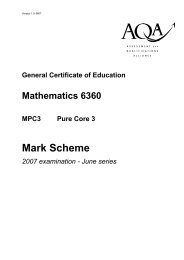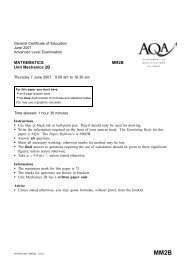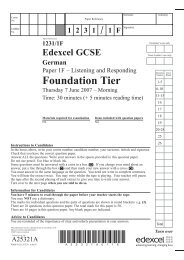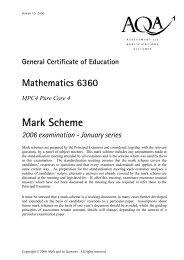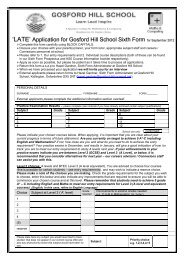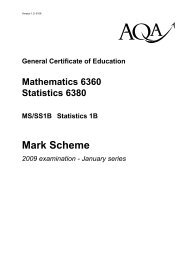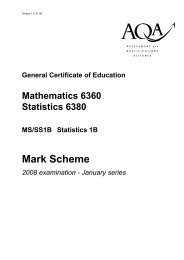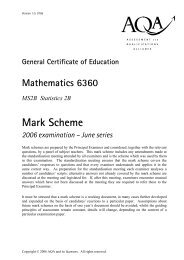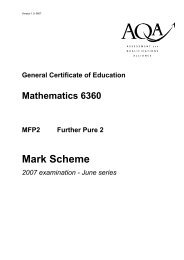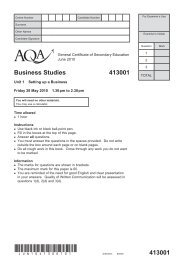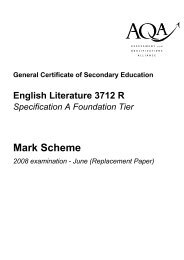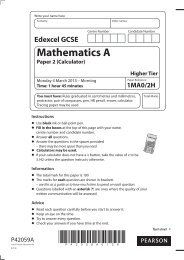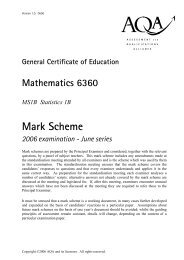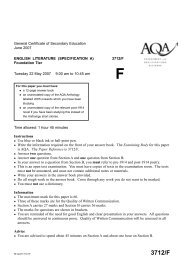GCSE English Language A Paper 1 Higher Mark - Gosford Hill School
GCSE English Language A Paper 1 Higher Mark - Gosford Hill School
GCSE English Language A Paper 1 Higher Mark - Gosford Hill School
You also want an ePaper? Increase the reach of your titles
YUMPU automatically turns print PDFs into web optimized ePapers that Google loves.
abcGeneral Certificate of Secondary Education<strong>English</strong> 3702 RSpecification A <strong>Paper</strong> 1H R<strong>Mark</strong> Scheme2008 examination – June (Replacement)
<strong>Mark</strong> schemes are prepared by the Principal Examiner and considered, together with therelevant questions, by a panel of subject teachers. This mark scheme includes anyamendments made at the standardisation meeting attended by all examiners and is the schemewhich was used by them in this examination. The standardisation meeting ensures that themark scheme covers the candidates’ responses to questions and that every examinerunderstands and applies it in the same correct way. As preparation for the standardisationmeeting each examiner analyses a number of candidates’ scripts: alternative answers notalready covered by the mark scheme are discussed at the meeting and legislated for. If, afterthis meeting, examiners encounter unusual answers which have not been discussed at themeeting they are required to refer these to the Principal Examiner.It must be stressed that a mark scheme is a working document, in many cases furtherdeveloped and expanded on the basis of candidates’ reactions to a particular paper.Assumptions about future mark schemes on the basis of one year’s document should beavoided; whilst the guiding principles of assessment remain constant, details will change,depending on the content of a particular examination paper.Further copies of this <strong>Mark</strong> Scheme are available to download from the AQA Website: www.aqa.org.ukCopyright © 2008 AQA and its licensors. All rights reserved.COPYRIGHTAQA retains the copyright on all its publications. However, registered centres for AQA are permitted to copy materialfrom this booklet for their own internal use, with the following important exception: AQA cannot give permission tocentres to photocopy any material that is acknowledged to a third party even for internal use within the centre.Set and published by the Assessment and Qualifications Alliance.The Assessment and Qualifications Alliance (AQA) is a company limited by guarantee registered in England and Wales (company number 3644723) and a registered charity (registered charity number 1073334).Registered address: AQA, Devas Street, Manchester M15 6EXDr Michael Cresswell Director General2
<strong>English</strong> A - AQA <strong>GCSE</strong> <strong>Mark</strong> Scheme 2008 June series R<strong>GCSE</strong> <strong>English</strong> 2008<strong>Paper</strong> 1 Tier H <strong>Mark</strong> SchemeINTRODUCTIONExaminers will be expected to read the scripts in their allocation carefully and to make everyeffort to look positively for achievement throughout the ability range. They will be expected toannotate the scripts in order to show subsequent readers what evidence they have found for theachievement of the particular descriptors in the mark bands and will be expected to give a markfor each answer in the right hand margin at the end of the answer.There is a common marking spine which runs across all components. In this way the wholeexamination can be integrated by using a common grade related system for all components.There are some rules, however, about the mark ranges that can be given.TIER HOn Tier H, the questions are targeted at Grades A to D. However, it is quite possible that on anindividual essay or component candidates may perform below grade D and so there are alsodescriptors for grades below D.DECIDING ON A MARKExaminers must use the full range of marks. Work exhibiting the highest skills should beconsidered for full marks.<strong>Mark</strong>ing throughout must be on a ‘best-fit’ principle. Where there are both strengths andweaknesses in a particular answer, examiners should consider carefully which band is the bestfit for the performance overall.The descriptors are an attempt to guide examiners to an understanding of the qualities normallyexpected of, or ‘typical’ of, work in the band. They must not be interpreted as hurdlestatements.Once the mark has been decided upon, by the identification in the body of the script where thedescriptor has been met, then the mark should be placed, circled in the right hand margin.ANNOTATION OF SCRIPTSIt is important that while they are marking in red, examiners note on the script where they havefound specific evidence of candidates having achieved a descriptor. It is likely that examinerswill be making more extensive annotations at the beginning of the marking period than at theend, but every mark must be justified by a written comment. Ticks should be used to identifyevidence of particular skills. Random ticking is extremely unhelpful.The best kinds of comments are where a particular element of the descriptors is identifiedclearly and concisely. The point of making such comments is to allow subsequent readers tounderstand what you are identifying as positive achievement and where you are seeing material3
<strong>English</strong> A - AQA <strong>GCSE</strong> <strong>Mark</strong> Scheme 2008 June series Rwhich gains credit. It is to share your marking process with those reading your scripts later(Team Leaders, Assistant Principals, Principals, the Chief, Awarders, QCA, scrutineers etc.).Examiners are asked to number the scripts in their allocation in the order in which they markthem. The first script marked is ‘1’. Go right through the allocation. Number the script in thetop left hand corner of the front cover of the script. If you do extra scripts just keep numberingthrough.PROBLEMSWhere an examiner has great difficulty in assessing a script, (s)he can draw it to the attention ofthe Principal Examiner at the end of the marking season by placing RSE (Refer to SeniorExaminer) on the script and attaching the relevant Form EX/SRF. This means that it will besent to the final meeting of examiners, the occasion where all the problems are looked at and adecision arrived at. Very occasionally a script is very hard to read or illegible. If you have oneof these, you should give the mark you think it deserves, but you must also mark it RSE andcomplete Form EX/SRF so that it can be deciphered fully later on.RUBRIC INFRINGEMENTSThere may well be a few candidates who answer the wrong number of questions. If so, markthem all and count the highest score for those eligible under the terms of the rubric. Thus themarks should be entered which are the highest according to the allowable rubric.RECORDINGIn addition to recording the mark for a question at the end of the answer, examiners must alsofill in the marks on the front cover of the answer booklet.The grid on the front of the answer booklet should look like this:1a 51b 22a 42b 52c 53 147Then put the total mark for the paper in the box on the top right hand corner called ‘For OfficeUse Only’.Please make sure that you add your initials underneath the total for the paper.4
<strong>English</strong> A - AQA <strong>GCSE</strong> <strong>Mark</strong> Scheme 2008 June series R<strong>GCSE</strong> <strong>English</strong> 2008<strong>Paper</strong> 1 Tier HSection A: ReadingThis section covers the following Assessment Objectives:AO2 Reading (En2)Candidates are required to demonstrate their ability to:(i)(ii)(iii)(iv)(v)read, with insight and engagement, making appropriate references to texts anddeveloping and sustaining interpretations of them;distinguish between fact and opinion and evaluate how information is presented;follow an argument, identifying implications and recognising inconsistencies;select material appropriate to their purpose, collate material from different sources, andmake cross references;understand and evaluate how writers use linguistic, structural and presentational devicesto achieve their effects, and comment on ways language varies and changes.Assessment 1(a) 1(b) 2(a) 2(b)Objectives(i) ! ! ! !(ii) !(iii) ! ! (!) !(iv) ! ! ! !(v) ! !5
<strong>English</strong> A - AQA <strong>GCSE</strong> <strong>Mark</strong> Scheme 2008 June series RRead Item 1, the article called ‘The first greenies’ by Michelle Hanson.1(a)According to Michele Hanson, what could ‘today’s green consumers’ learn from‘Britain in the 40s and 50s’?.(7 marks)Grades and Skills Descriptors<strong>Mark</strong>s0 • nothing relevant written1 mark‘some simplecomment’2/3 marks‘attempts toengage’4/5 marks‘clear attempt’6/7 marks‘detailed/shaped &absorbed ’• some simple supported comment• mainly narrative description• refers to some appropriate detail• some views put forward• some extended supportedcomments• unstructured response and tendsto paraphrase• some identification of main points[and some views]• attempts to engage with task• clear and effective attempt toengage with the task• structured response• selects [& comments] onHanson’s views• a variety of points put forward• a full understanding of the pointsput forward• material fully absorbed andshaped for purpose• references integrated intoargument• a detailed and conceptualisedresponseContent DescriptorsWhat today’s green consumerscould learn:• ethical living• make do and mend• not to waste resources• to re-use everything• to re-use brown paper• not to waste food• turn lights off• housework• use cloth nappies• return bottles to shop• re-cycle clothes• re-use sheets• mend ladders in stockings• etc.! = what we learn6
<strong>English</strong> A - AQA <strong>GCSE</strong> <strong>Mark</strong> Scheme 2008 June series R1(b)What criticisms does Michele Hanson make of other people’s behaviour and attitudes?(6 marks)Grades and Skills Descriptors<strong>Mark</strong>s0 • nothing relevant written1 mark‘some simplecomment’2 marks‘attempts toengage’3/4 marks‘clear attempt’5/6 marks‘detailed/shaped &absorbed’• some simple supported comment• mainly narrative description• refers to some appropriate detail• some criticisms (facts andopinions) alluded to• some extended supportedcomments• unstructured response and tendsto paraphrase• some identification of criticisms(facts and opinions)• attempts to engage with task• clear and effective attempt toengage with task• structured response• selects [& comments on] somecriticisms (facts and opinions andtheir use)• a variety of criticisms/facts andopinions put forward• a full understanding of the [usesof] criticisms (facts and opinionsand how they are used)• material fully absorbed andshaped for purpose• references integrated intoargument• a detailed and conceptualisedresponseContent DescriptorsCriticisms:• that today’s generation iswasteful• youngsters throwing food around• Jennifer’s children who leavelights on• today’s housewives for having iteasy• today’s mothers for usingdisposable nappies• today’s youth for not re-cyclingclothes and accessories• today’s ‘pampered creatures• expect generalised points• etc.’! = criticism7
<strong>English</strong> A - AQA <strong>GCSE</strong> <strong>Mark</strong> Scheme 2008 June series RNow Read Item 2, the front page from The Independent newspaper.Now look again at Item1 and Item 2 together.2(a)Write about the ways in which presentational devices are used in each item.(8 marks)Grades and Skills Descriptors<strong>Mark</strong>s0 • nothing relevant written1/2 mark‘some simplecomment’3/4 marks‘attempts toengage’5/6 marks‘clear attempt’7/8 marks‘detailed/shaped &absorbed’• some simple supported comment• mainly narrative description• refers to some appropriate detail• some reference to thepresentational devices used• some extended supportedcomments• unstructured response and tendsto paraphrase• some identification ofpresentational devices used• attempts to engage with task andto explain how the devices areused• clear and effective attempt toengage with task• structured response• selects and comments on at leastone device from each item• a clear attempt to explain how thedevices are used• a full understanding of what isbeing asked• material fully absorbed and shapedfor purpose• references integrated intoargument• a detailed and conceptualisedresponse with detailed reasonsContent DescriptorsPresentational devices &suggested uses in Item 1• old-fashioned colours – to conjureup the 40s and 50s• old-fashioned images – samereason• green headline – green issues• clear font – to make it more formal• headline – to attract attention bybeing coarse• in columns - to make it moreformally a newspaper• etc.Presentational devices &suggested uses in Item 2• image of a swede – a down toearth veg wraped in cling film andit exemplifies the main message• red text – to draw attention to themain issues• formal font – to connoteseriousness• large fonts – to amplify themeaning• colours – colours of the Swedishflag• etc.P1P2! = how used8
<strong>English</strong> A - AQA <strong>GCSE</strong> <strong>Mark</strong> Scheme 2008 June series R2(b) Compare the ways in which words are used for effect in each item. (6 marks)Grades and Skills Descriptors<strong>Mark</strong>s0 • nothing relevant written1 marks‘some simplecomment’2 marks‘attempts toengage’3/4 marks‘clear attempt’5/6 marks‘detailed/shaped &absorbed’• some simple supportedcomment• mainly narrative description• refers to some appropriate detail• some reference to words• some extended supportedcomments• unstructured response and tendsto paraphrase• some identification of wordsused in each item• attempts to compare• clear and effective attempt toengage with task• structured response• selects & comments using someappropriate terminology• at least one example from eachitem given with clear attempt tocompare• a full understanding of what isbeing asked• material fully absorbed andshaped for purpose• references integrated intoargument with a convincing useof terminology• a detailed and conceptualisedresponse which compares howwords are used for effect in eachitemContent Descriptorswords in item 1• the headlines• old-fashioned words, like ‘giblets’and ‘darning’• short sentences• long sentences• mixture of 1 st . and 3 rd . person• repetition• lots of short sentences in thefinal paragraph• etc.how they are used for effect initem 1 ?• to attract attention to the article• to give the article an historicaltruth• for effect• to make the most of the point• to give personal examples andviews and to give impersonaltruth• for rhetorical effect• to hammer home the mainpersonal opinion and point of thewriter• etc.words in item 2• demonstrative sentences• main words are highlighted• full stops lead to the headline• etc.how they are used for effect initem 2 ?• to make the article morebombastic• for effect• gives the headline an inevitability• etc.L1L2C! = used for effect9
<strong>English</strong> A - AQA <strong>GCSE</strong> <strong>Mark</strong> Scheme 2008 June series RSpecification A <strong>Paper</strong> 1, <strong>Higher</strong>, Section B: Writing to Argue, Persuade or AdviseAssessment ObjectivesAO3 (i) communicate clearly and imaginatively, using and adapting forms for different readersand purposesAO3 (ii) organise ideas into sentences, paragraphs and whole texts using a variety of linguisticand structural featuresAO3 (iii) use a range of sentence structures effectively with accurate punctuation and spellingDescriptors have been included for performance from U to A*. The skills descriptors representthe base line generic expectations whilst the content descriptors offer guidance on how thoseexpectations are likely to be demonstrated in a response.For each question, examiners are to record one mark out of 18 for AO3 (i) and (ii) combinedand a separate mark out of 9 for AO3 (iii). The total available marks for Section B questions istherefore 27.For AO3 (i)/(ii), assess answers in terms of the levels which follow, i.e. the Communication andOrganisation descriptors. For AO3 (iii), use the separate set of levels which follow. Place themarks in the margin at the end of the answer, circled, with the AO3 (i)/(ii) total above the AO3(iii) total.The Skills descriptors embody the two equally weighted Assessment Objectives in theCommunication and Organisation <strong>Mark</strong> Schemes. These are amplified and customised for thequestion in the Content Descriptors. Examiners will need to look closely at the ContentDescriptors in order to find the appropriate band, and then to check across to the SkillsDescriptors to confirm or modify the preliminary judgement. Taking both Skills and ContentDescriptors together will determine how high or low in the band the mark should be. Rememberthat to be placed in a particular band the work will satisfy some (but not necessary all) of thecriteria at that level. The precise mark awarded will be determined by the extent to which theanswer matches the descriptors set out in the appropriate level.The one Assessment Objective tested in the Sentence Structures, Punctuation and Spelling<strong>Mark</strong> Scheme has been split into its three constituent parts. These are amplified andcustomised in the Content Descriptors. The same process should be followed as in theprevious <strong>Mark</strong> Scheme to determine the mark to be awarded.In each case, a best fit principle may need to be applied where performance in response to theAssessment Objectives or parts of Assessment Objectives is uneven.Any valid responses should be rewarded. Remember that candidates are writing in timedconditions.10
<strong>English</strong> A - AQA <strong>GCSE</strong> <strong>Mark</strong> Scheme 2008 June series R3 Older people often blame younger people for today’s problems. Write an article in whichyou argue that older people are the ones to blame.(27 marks)AO3 (i)/(ii) Communication and Organisation<strong>Mark</strong>s Skills Descriptors Content Descriptors1-2 • communicates some meaning • some words in appropriate order• some simple sequencing of ideas • one or more points made3-4 • communicates some meaning withoccasional sense of purpose andaudience• ideas are sequenced simply, butgenerally appropriately5-6 • clear communication of ideas withmore sense of purpose andaudience• uses some organisational devicesappropriately with occasionalconscious selection of words7-8 • sustained awareness of purpose andaudience• more conscious attempt to organisesentences into paragraphs withsome attempt to use vocabulary foreffect• makes one or more directreference to an article arguing thatolder people are to blame• an indication of awareness of needfor formality• may express personal feelingsstrongly but with little or no use ofsupportive detail• some attempt to shape points intoan article• a number of arguments put forward• uses isolated points from stimulusmaterial or copies some points indetail• shows awareness of wideaudience at different points eitherby use of second person or byoccasional use of a more formalregister• may demonstrate occasionalattempt to paragraph though likelyto be random• some attempt to link ideas usingcausal connectives e.g. because,so• occasional attempt to uselinguistic/ presentational devicese.g. repetition, capitals, bold• linked arguments put forwardwhich may be developed in ageneralised way• addresses wide audience directlyand/or starts consciously to use amore formal register, though stillevidence of colloquial language• begins to use rhetorical devices,for example, rhetorical questionswith occasional evidence oflanguage being used emotively• discursive markers e.g. the firstpoint …, where used, aremechanical and obvious• more frequent use of linguistic/presentational devices e.g.repetition for effect11
<strong>English</strong> A - AQA <strong>GCSE</strong> <strong>Mark</strong> Scheme 2008 June series R9-10 • conscious attempt to suit the needsof purpose and audience andbegins to engage reader’s response• clear, if mechanical, paragraphingwith more conscious use ofvocabulary for effect11-12 • clear identification with purpose andaudience; begins to sustain reader’sresponse• evidence of structure with usuallycoherent paragraphs and clearselection of vocabulary for effect13-14 • form, content and style are generallymatched to purpose and audience• well structured, starting to useparagraphs to enhance meaningand with increasing sophistication invocabulary choice• presents argument with a variety ofreasons• evidence which may be drawn frompersonal experience and stimulusmaterial may be used to supportargument• register almost wholly formal withsome attempt to control tone e.g. tobe judgemental, indignant etc.• organised points with paragraphingmarking some shift in argument• more appropriate use of widerrange of rhetorical devices anddiscursive markers though stillmechanical and superimposed• argument is starting to becomemore detailed with a clearawareness of alternative viewpointsand some second guessing• some sense of varying emphasisfor effect with conscious use of achosen tone e.g. confrontational orplacatory• confident use of devices such asanecdote in context and rhetoricalquestions• paragraphs are competently linkedby content and language• discursive markers are becomingmore integrated and are used toenhance the argument; may markboth cause and effect e.g. as aresult of this … consequently …• detailed and well developed;starting to use and support abstractargument, though not alwaysconvincingly carried through• begins to anticipate and evaluatepotential audience response• may use argument and counterargumentwith competence• range of paragraph structurescoherently linked• vocabulary range successfullyreflects more sophisticated level ofargument and attempt to influencereader• discursive markers are nowcoherently integrated12
<strong>English</strong> A - AQA <strong>GCSE</strong> <strong>Mark</strong> Scheme 2008 June series R15-16 • form, content and style areconsistently matched to purposeand audience• coherently structured with fluentlylinked sentence structures andparagraphs and evidence ofconscious crafting17-18 • form, content and style areassuredly matched to purpose andaudience; distinctive andconsistently effective• controlled and sustained craftingwith highly effective and delightfulvocabulary choices• argues successfully andconvincingly; well informed,drawing on a range of sources• growing subtlety of purpose andability to adapt tone to manipulatereader• controls a range of means to gainemphasis (e.g. one sentenceparagraph) and demonstratealternative points of view (e.g.anecdote, reference)• fluent control of range of devicesand discursive markers with anextensive vocabulary range• may use satire, irony etc. butalways fittingly and in context• demonstrates intellectual rigour andthe ability to integrate a range ofcomplex details from variedsources• discursive markers, rhetoricaldevices etc. are integrated intowhole seamlessly and persuasively• may use some inventive structuraland/or linguistic devices13
<strong>English</strong> A - AQA <strong>GCSE</strong> <strong>Mark</strong> Scheme 2008 June series RAO3 (iii) Sentence Structures, Punctuation and Spelling<strong>Mark</strong>s Skills Descriptors Content Descriptors• some sentences1 • some accuracy in spelling ofsimple words• random punctuation• some monosyllabic words speltcorrectly2-3 • in sentences • may use mainly simple and compoundsentences, with occasional complexsentences; may use discourse markersin an enhanced way• generally accurate basicspelling• evidence of consciouspunctuation4-5 • uses a range of securelydemarcated sentencestructures• simple words spelt correctly• occasional full stops• some conscious variation of syntaxthough not always grammaticallysecure; may use complex sentenceswith appropriate discourse markers e.g.because, on the other hand• commonly used words spelt correctly• some accurate spelling of morecomplex words• starts to use a range of • general accuracy in use of capitalpunctuationletters and full stops6-7 • uses sentence forms for effect • constructions linked securely todiscourse markers; may use rhetoricaldevices, first person, imperatives,modal verbs, repetition, shortsentences, rhetorical questions and/orexclamations for effect• generally secure in spelling • generally secure spelling of irregular,latinate, complex words• generally secure in punctuationwhich clarifies meaning andpurpose8-9 • uses full range of appropriatesentence structures• achieves a high level oftechnical accuracy in spelling• achieves a high level oftechnical accuracy inpunctuation• generally accurate in sentencedemarcation, use of commas, questionmarks etc.• clear and controlled, manipulation ofsentence structures for effect; may usea wide range of appropriate discoursemarkers linked to syntactical choice;may use syntactical variety to buildrhetorical power throughout paragraphs• accurate spelling• range of punctuation used in asophisticated manner; colons and semicolonsused correctly when appropriate14
<strong>English</strong> A - AQA <strong>GCSE</strong> <strong>Mark</strong> Scheme 2008 June series R4 Write the text for a speech for an assembly persuading the school or college to start acampaign against waste.(27 marks)AO3 (i)/(ii) Communication and Organisation<strong>Mark</strong>s Skills Descriptors Content Descriptors1-2 • communicates some meaning • some words in appropriate order• some simple sequencing of ideas • one or more points made3-4 • communicates some meaning withoccasional sense of purpose andaudience• ideas are sequenced simply, butgenerally appropriate5-6 • clear communication of ideas withmore sense of purpose andaudience• uses some organisational devicesappropriately with occasionalconscious selection of words7-8 • sustained awareness of purpose andaudience• more conscious attempt to organisesentences into paragraphs withsome attempt to use vocabulary foreffect• makes one or more directreferences to trying to persuadeschool or college to start acampaign against waste• an indication of awareness of needfor a sense of audience• may express personal feelingsstrongly but with little or no use ofsupportive detail• some attempt to shape points intothe form of a speech• a number of points of persuasionput forward• uses isolated points from stimulusmaterial or copies some points indetail• shows awareness of mixed ageaudience at different points eitherby use of second person or byoccasional use of an appropriateregister• may demonstrate occasionalattempt to paragraph though likelyto be random• some attempt to link ideas usingconnectives e.g. because, so• occasional attempt to uselinguistic/ presentational devicese.g. repetition, capitals, bold• linked material which may bedeveloped in a generalised way• addresses school audience directlyand/or starts consciously to use amore appropriate register, withevidence of colloquial language• begins to use rhetorical devices,for example, rhetorical questionswith occasional evidence oflanguage being used emotively• discursive markers e.g. the firstpoint …, where used, aremechanical and obvious• more frequent use of linguistic/presentational devices e.g.repetition for effect15
<strong>English</strong> A - AQA <strong>GCSE</strong> <strong>Mark</strong> Scheme 2008 June series R9-10 • conscious attempt to suit the needsof purpose and audience and beginsto engage reader’s response• clear, if mechanical, paragraphingwith more conscious use ofvocabulary for effect11-12 • clear identification with purpose andaudience; begins to sustain reader’sresponse• evidence of structure with usuallycoherent paragraphs and clearselection of vocabulary for effect13-14 • form, content and style are generallymatched to purpose and audience• well structured, starting to useparagraphs to enhance meaningand with increasing sophistication invocabulary choice• persuades by variety of means• evidence which may be drawnfrom personal experience andstimulus material is used topersuade• register mainly appropriate withsome attempt to control tone e.g.to be persuasive, funny, serious,etc.• organised points with paragraphingmarking some stages ofpersuasion• more appropriate use of widerrange of rhetorical devices anddiscursive markers though stillmechanical and superimposed• persuasion is starting to becomemore detailed with a clearawareness of the features likely topersuade students• some sense of varying emphasisfor effect with conscious use of achosen tone• paragraphs are competently linkedby content and language• confident use of devices such asanecdote in context and rhetoricalquestions• discursive markers are becomingmore integrated and are used topersuade• detailed and well developed;starting to use and supportpersuasion though not alwaysconvincingly carried through• begins to anticipate and evaluatepotential audience response• may use variety of rhetoricaldevices with competence• range of speech sectionscoherently linked• vocabulary range successfullyreflects more sophisticated level ofpersuasion and attempt toinfluence reader• discursive markers are nowcoherently integrated16
<strong>English</strong> A - AQA <strong>GCSE</strong> <strong>Mark</strong> Scheme 2008 June series R15-16 • form, content and style areconsistently matched to purpose andaudience• coherently structured with fluentlylinked sentence structures andparagraphs and evidence ofconscious crafting17-18 • form, content and style areassuredly matched to purpose andaudience; distinctive andconsistently effective• controlled and sustained craftingwith highly effective and delightfulvocabulary choices• persuades successfully andconvincingly; well informed,drawing on a range of sources• growing subtlety of purpose andability to adapt tone to manipulatereader• controls a range of means to gainemphasis (e.g. one sentenceparagraph) and demonstratevariety of possible consequences• fluent control of range of devicesand discursive markers with anextensive vocabulary range• may use satire, irony etc. butalways fittingly and in context• demonstrates intellectual rigourand the ability to integrate a rangeof persuasive techniques• discursive markers, rhetoricaldevices etc. are integrated intowhole seamlessly and persuasively• may use some inventive structuraland/or linguistic devices17
<strong>English</strong> A - AQA <strong>GCSE</strong> <strong>Mark</strong> Scheme 2008 June series RAO3 (iii) Sentence Structures, Punctuation and Spelling<strong>Mark</strong> Skills Descriptors Content Descriptors• some sentences1 • some accuracy in spelling ofsimple words• random punctuation• some monosyllabic words speltcorrectly2-3 • in sentences • may use mainly simple andcompound sentences, withoccasional complex sentences;may use discourse markers in anenhanced way• generally accurate basic spelling • simple words spelt correctly• evidence of conscious punctuation • occasional full stops4-5 • uses a range of securelydemarcated sentence structure• some conscious variation of syntaxthough not always grammaticallysecure; may use complexsentences with appropriatediscourse markers e.g. because,on the other hand• commonly used words spelt• some accurate spelling of morecomplex wordscorrectly• starts to use a range of• general accuracy in use of capitalpunctuationletters and full stops6-7 • uses sentence forms for effect • constructions linked securely todiscourse markers; may userhetorical devices, first person,imperatives, modal verbs,repetition, short sentences,rhetorical questions and/orexclamations for effect• generally secure in spelling • generally secure spelling ofirregular, latinate, complex words• generally secure in punctuationwhich clarifies meaning andpurpose8-9 • uses full range of appropriatesentence structures• achieves a high level of technicalaccuracy in spelling• achieves a high level of technicalaccuracy in punctuation• generally accurate in sentencedemarcation, use of commas,question marks etc.• clear and controlled, manipulationof sentence structures for effect;may use a wide range ofappropriate discourse markerslinked to syntactical choice; mayuse syntactical variety to buildrhetorical power throughoutsections of speech• accurate spelling• range of punctuation used in asophisticated manner; colons andsemi-colons used correctly whenappropriate18
<strong>English</strong> A - AQA <strong>GCSE</strong> <strong>Mark</strong> Scheme 2008 June series R5 Write an article for a school magazine advising Year 11 students what to do with theirlives after their <strong>GCSE</strong>s.(27 marks)AO3 (i)/(ii) Communication and Organisation<strong>Mark</strong>s Skills Descriptors Content Descriptors1-2 • communicates some meaning • some words in appropriate order• some simple sequencing of ideas • one or more points made3-4 • communicates some meaning withoccasional sense of purpose andaudience• makes one or more directreferences to giving advice aboutwhat to do with their lives after<strong>GCSE</strong>s• an indication of awareness of needfor formality• may express personal feelingsstrongly but with little or no use ofsupportive detail• ideas are sequenced simply, butgenerally appropriately• some attempt to shape points intoan article5-6• clear communication of ideas withmore sense of purpose andaudience• a number of points made• shows awareness of studentaudience at different points in thearticle either by use of secondperson or by occasional use of amore appropriate register7-8• uses some organisational devicesappropriately with occasionalconscious selection of words• sustained awareness of purposeand audience• more conscious attempt to organisesentences into paragraphs withsome attempt to use vocabulary foreffect• may demonstrate occasionalattempt to paragraph though likelyto be random• some attempt to link ideas usingcausal connectives e.g. because,so• occasional attempt to uselinguistic/presentational devices e.g.repetition, capitals, bold• linked advice put forward which maybe developed in a generalised way• addresses audience directly and/orstarts consciously to use a moreformal register, plus evidence ofcolloquial language• begins to use rhetorical devices, forexample, rhetorical questions withoccasional evidence of languagebeing used emotively• discursive markers e.g. the firstpoint …, where used, aremechanical and obvious• more frequent use of linguistic/presentational devices e.g.repetition for effect19
<strong>English</strong> A - AQA <strong>GCSE</strong> <strong>Mark</strong> Scheme 2008 June series R9-1011-1213-14• conscious attempt to suit the needsof purpose and audience andbegins to engage reader’s response• clear, if mechanical, paragraphingwith more conscious use ofvocabulary for effect• clear identification with purpose andaudience; begins to sustain reader’sresponse• evidence of structure with usuallycoherent paragraphs and clearselection of vocabulary for effect• form, content and style aregenerally matched to purpose andaudience• well structured, starting to useparagraphs to enhance meaningand with increasing sophistication invocabulary choice• presents advice with a variety ofreasons• evidence which may be drawn frompersonal experience and stimulusmaterial is used to supportargument• register almost wholly formal withsome attempt to control tone• organised points with paragraphingmarking some stages in advice• more appropriate use of widerrange of rhetorical devices anddiscursive markers though stillmechanical and superimposed• advice is starting to become moredetailed with a clear awareness ofthe type of advice which would behelpful• some sense of varying emphasis foreffect with conscious use of achosen tone• confident use of devices such asanecdote in context and rhetoricalquestions• paragraphs are competently linkedby content and language• discursive markers are becomingmore integrated and are used toenhance the advice; may mark bothcause and effect e.g. as a result ofthis … consequently …• detailed and well-developed;starting to use and support advice,though not always convincinglycarried through• begins to anticipate and evaluatepotential response of the readership• may use conditional(s) withcompetence• range of paragraph structurescoherently linked• vocabulary range successfullyreflects more sophisticated level ofadvice and attempt to influenceteachers• discursive markers are nowcoherently integrated20
<strong>English</strong> A - AQA <strong>GCSE</strong> <strong>Mark</strong> Scheme 2008 June series R15-1617-18• form, content and style areconsistently matched to purposeand audience• coherently structured with fluentlylinked sentence structures andparagraphs and evidence ofconscious crafting• form, content and style areassuredly matched to purpose andaudience; distinctive andconsistently effective• controlled and sustained craftingwith highly effective and delightfulvocabulary choices• advises successfully andconvincingly; well informed, drawingon a range of sources• growing subtlety of purpose andability to adapt tone to manipulatereader• controls a range of means to gainemphasis (e.g. one sentenceparagraph) and demonstratepossible consequences• fluent control of range of devicesand discursive markers with anextensive vocabulary range• may use exaggeration, irony etc.but always fittingly and in context• demonstrates intellectual rigour andthe ability to integrate a range ofcomplex details from varied sources• discursive markers, rhetoricaldevices etc. are integrated intowhole seamlessly and persuasively• may use some inventive structuraland/or linguistic devices21
<strong>English</strong> A - AQA <strong>GCSE</strong> <strong>Mark</strong> Scheme 2008 June series RAO3 (iii) Sentence Structures, Punctuation and Spelling<strong>Mark</strong> Skills Descriptors Content Descriptors• some sentences1 • some accuracy in spelling of • some monosyllabic words spelt correctlysimple words• random punctuation2-3 • in sentences • may use mainly simple and compoundsentences, with occasional complexsentences; may use discourse markers inan enhanced way• generally accurate basicspelling• evidence of consciouspunctuation4-5 • uses a range of securelydemarcated sentencestructures• simple words spelt correctly• occasional full stops• some conscious variation of syntaxthough not always grammatically secure;may use complex sentences withappropriate discourse markers e.g.because, on the other hand• some accurate spelling of • commonly used words spelt correctlymore complex words• starts to use a range ofpunctuation• general accuracy in use of capital lettersand full stops6-7 • uses sentence forms for effect • constructions linked securely to discoursemarkers; may use rhetorical devices, firstperson, imperatives, modal verbs,repetition, short sentences, rhetoricalquestions and/or exclamations for effect• generally secure in spelling • generally secure spelling of irregular,latinate, complex words• generally secure inpunctuation which clarifiesmeaning and purpose• generally accurate in sentencedemarcation, use of commas, questionmarks etc8-9 • uses full range of appropriatesentence structures• clear and controlled, manipulation ofsentence structures for effect; may use awide range of appropriate discoursemarkers linked to syntactical choice; mayuse syntactical variety to build rhetoricalpower throughout paragraphs• achieves a high level oftechnical accuracy in spelling• achieves a high level oftechnical accuracy inpunctuation• accurate spelling• range of punctuation used in asophisticated manner; colons and semicolonsused correctly when appropriate22
<strong>English</strong> A - AQA <strong>GCSE</strong> <strong>Mark</strong> Scheme 2008 June series R6 Your local community has been awarded a grant to build either a sports centre or a livemusic venue. Write a letter to your local paper arguing for the money to be spent on theone you prefer and persuading readers to support you.(27 marks)AO3 (i)/(ii) Communication and Organisation<strong>Mark</strong>s Skills Descriptors Content Descriptors1-2 • communicates some meaning • some words in appropriate order• some simple sequencing of ideas • one or more points made3-4 • communicates some meaning withoccasional sense of purpose andaudience• makes one or more direct referenceto either a sports centre or livemusic venue• an indication of awareness of needfor formality• may express personal feelingsstrongly but with little or no use ofsupportive detail• ideas are sequenced simply, butgenerally appropriately• some attempt to shape points intoformat appropriate for a letter5-6• clear communication of ideas withmore sense of purpose andaudience• a number of arguments put forwardalong with some persuasion• shows awareness of the issuesinvolved and wider audience atdifferent points either by use ofsecond person or by occasional useof a more formal register7-8• uses some organisational devicesappropriately with occasionalconscious selection of words• sustained awareness of purposeand audience• more conscious attempt to organisesentences into paragraphs withsome attempt to use vocabulary foreffect• may demonstrate occasionalattempt to paragraph though likelyto be random• some attempt to link ideas usingcausal connectives e.g. because, so• occasional attempt to use linguistic/presentational devices e.g.repetition, capitals, bold• linked arguments put forward whichmay be developed in a generalisedway and an attempt to argue andpersuade• addresses audience directly and/orstarts to consciously use anappropriate register• begins to use rhetorical devices, forexample, rhetorical questions withoccasional evidence of languagebeing used emotively• discursive markers e.g. the firstpoint …, where used, aremechanical and obvious• more frequent use of linguistic/presentational devices e.g.repetition for effect23
<strong>English</strong> A - AQA <strong>GCSE</strong> <strong>Mark</strong> Scheme 2008 June series R9-1011-1213-14• conscious attempt to suit the needsof purpose and audience andbegins to engage reader’s response• clear, if mechanical, paragraphingwith more conscious use ofvocabulary for effect• clear identification with purpose andaudience; begins to sustainaudience response• evidence of structure with usuallycoherent paragraphs and clearselection of vocabulary for effect• form, content and style aregenerally matched to purpose andaudience• well structured, starting to useparagraphs to enhance meaningand with increasing sophistication invocabulary choice• presents persuasion and argumentwith a variety of reasons• evidence which may be drawn frompersonal experience and stimulusmaterial is used to supportargument• register mainly consistent formalwith some attempt to control tonee.g. to be cajoling, indignant etc.• organised points with paragraphingmarking some shift in argument andpersuasion• more appropriate use of wider rangeof rhetorical devices and discursivemarkers though still mechanical andsuperimposed• persuasion and argument arestarting to become more detailedwith a clear awareness of alternativeviewpoints and some secondguessing• some sense of varying emphasis foreffect with conscious use of achosen tone e.g. confrontational orplacatory• confident use of devices such asanecdote in context and rhetoricalquestions• paragraphs are competently linkedby content and language• discursive markers are becomingmore integrated and are used toenhance the argument; may markboth cause and effect e.g. as aresult of this ….. so …..• detailed and well developed; startingto use and support argument andpersuasion, though not alwaysconvincingly carried through• begins to anticipate and evaluatepotential response• may use argument and counterargumentwith competence• range of paragraph structurescoherently linked• vocabulary range successfullyreflects more sophisticated level ofargument and persuasion andattempt to influence reader• discursive markers are nowcoherently integrated24
<strong>English</strong> A - AQA <strong>GCSE</strong> <strong>Mark</strong> Scheme 2008 June series R15-1617-18• form, content and style areconsistently matched to purposeand audience• coherently structured with fluentlylinked sentence structures andparagraphs and evidence ofconscious crafting• form, content and style areassuredly matched to purpose andaudience; distinctive andconsistently effective• controlled and sustained craftingwith highly effective and delightfulvocabulary choices• persuades and argues successfullyand convincingly; well-informed,drawing on a range of sources• growing subtlety of purpose andability to adapt tone to manipulatereader• controls a range of means to gainemphasis (e.g. one sentenceparagraph) and demonstratealternative points of view (e.g.anecdote, reference)• fluent control of range of devicesand discursive markers with anextensive vocabulary range• may use satire, irony etc. but alwaysfittingly and in context• demonstrates intellectual rigour andthe ability to integrate a range ofcomplex details from varied sources• discursive markers, rhetoricaldevices etc. are integrated intowhole seamlessly and persuasively• may use some inventive structuraland/or linguistic devices25
<strong>English</strong> A - AQA <strong>GCSE</strong> <strong>Mark</strong> Scheme 2008 June series RAO3 (iii) Sentence Structures, Punctuation and Spelling<strong>Mark</strong>s Skills Descriptors Content Descriptors• some sentences1 • some accuracy in • some monosyllabic words spelt correctlyspelling of simple words• random punctuation2-3 • in sentences • may use mainly simple and compoundsentences, with occasional complexsentences; may use discourse markers in anenhanced way• generally accurate basic • simple words spelt correctlyspelling• evidence of conscious • occasional full stopspunctuation4-5 • uses a range of securelydemarcated sentencestructures• some accurate spellingof more complex words• starts to use a range ofpunctuation6-7 • uses sentence forms foreffect• generally secure inspelling• generally secure inpunctuation whichclarifies meaning andpurpose8-9 • uses full range ofappropriate sentencestructures• achieves a high level oftechnical accuracy inspelling• achieves a high level oftechnical accuracy inpunctuation• some conscious variation of syntax though notalways grammatically secure; may usecomplex sentences with appropriate discoursemarkers e.g. because, on the other hand• commonly used words spelt correctly• general accuracy in use of capital letters andfull stops• constructions linked securely to discoursemarkers; may use rhetorical devices, firstperson, imperatives, modal verbs, repetition,short sentences, rhetorical questions and/orexclamations for effect• generally secure spelling of irregular, latinate,complex words• generally accurate in sentence demarcation,use of commas, question marks etc.• clear and controlled, manipulation of sentencestructures for effect; may use a wide range ofappropriate discourse markers linked tosyntactical choice; may use syntactical varietyto build rhetorical power throughoutparagraphs• accurate spelling• range of punctuation used in a sophisticatedmanner; colons and semi-colons used correctlywhen appropriate26



